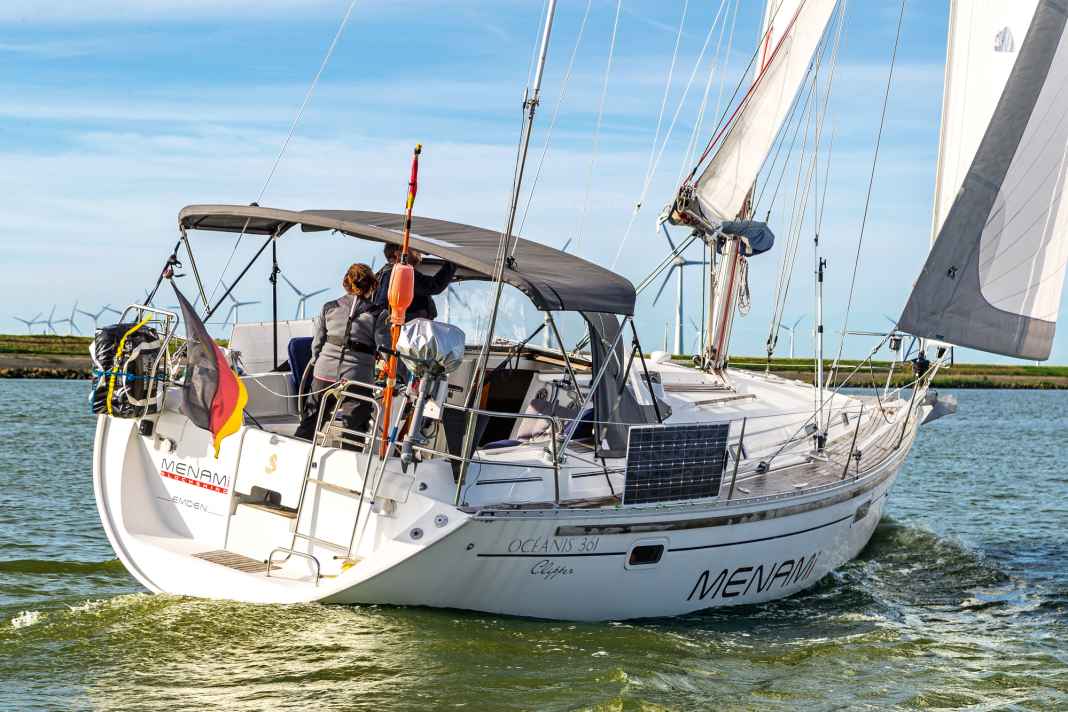





Charter giant Moorings opened a yacht sales office in Fort Lauderdale, Florida, in 1993. What does this have to do with a used Oceanis 361? The demand for purchase charter yachts was growing so enormously at the time that it made sense to open such a sales office. The monohull yachts came and still come from Beneteau and are called Moorings 362 or 363 when running under the Moorings flag, depending on how many cabins are installed.
The Oceanis 361 is a solid workhorse
Why did Moorings decide in favour of Beneteau? The French delivered what the charterers were looking for. Solid yachts that sail well and, more importantly, meet the tough requirements of the charter market: plenty of space below deck, large cockpits, easy to maintain, without a lot of frippery. The Oceanis 361 is such a boat, a workhorse. Top rig without trim options, solid laminated hull, shaft drive and large wet cell. At the same time, it sails without conjuring up big question marks on the helmsman's forehead. Very solid fare.
More cruising yachts as used boats:
It was also interesting for owners, as the Frenchwoman was also available with two cabins. In this case, the galley and forecastle are huge, and the aft cabin also has a seemingly enormous berth. The Berret-Racoupeau designers have skilfully positioned the galley, navigation table and wet room in the widest part of the boat, so that there is no impression of cramped space anywhere. There is also plenty of room for everyone in the cockpit, with a footrest in the centre so that you can sit opposite each other, even when the boat is lying down. And what is right for charter customers is cheap for owners. Because they too are often looking for space, solid construction and easy maintenance. The sailing characteristics and trimming options are sometimes of secondary importance.
Little draught: good in shallow water, bad at the cross
The test ship off Lemmer shows that the sails on the Oceanis can be quite good enough. The fairly new sails of the "Menami" are still standing quite well. When the wind starts blowing at around twelve knots, she sets off. A little rudder pressure, everything is perfectly manageable, six knots upwind are possible. Turning angles of 90 degrees only work in smooth water and with full concentration at the helm: a draught of 1.53 metres helps in shallow waters, but not on the cross.
When our colleagues tested the then new 361 at the end of the nineties, the wind was blowing at 6 Beaufort off Laboe. The Oceanis was only able to be upset by excessive agonising with full sail on the wind. The testers came to the conclusion at the time that the large beam made for enormous windward yaw when there was a lot of heel. Ultimately, the rudder would then be cancelled out and the boat would take off into the sun. Otherwise, everything is very controlled and true to track. Of course, she is not trim-sensitive, but a little bit goes a long way: halyard tension, lower leech, hole points, kicker, traveller and of course the sheets themselves help if the pressure increases too much. And you can still reef at some point.
A topsy-turvy world with the sheets on the Oceanis 361
Keyword pods: It's a topsy-turvy world here. The helmsman drives the genoa, the crew the main, that's how the winches are arranged. The fact that the helmsman cannot reach the mainsheet because it rests on the cabin roof is not really nice, but not really tragic either, as the forces of the rather compact top rig can usually be parried with the rudder: Who crosses with a full sail in six force winds?
When it finally starts to blow at 16 knots during the test off Lemmer, the boat even comes to life. Always with full control, with easily perceptible rudder pressure and simple operation. The owner could simplify this even more with higher quality fittings: better deflection blocks, strong lever clamps, slightly larger winches. Just the things that all mass-produced yachts skimp on, and also the things that lead to unnecessary friction and therefore work on the winches.
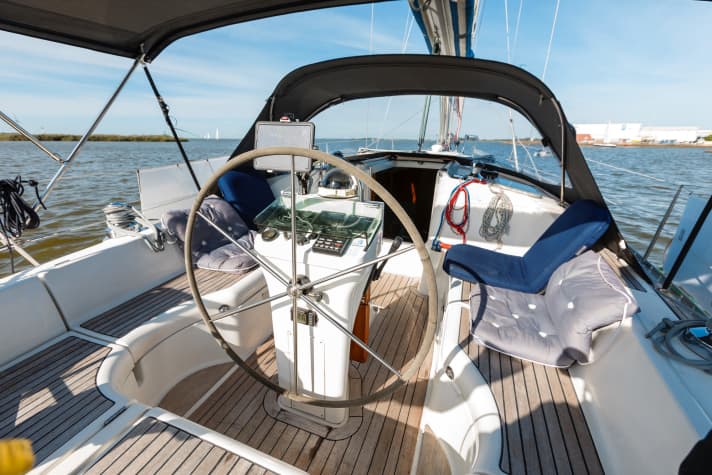
Another shortcoming under sail: Typically, a not-too-high top rig brings with it a large genoa. Paired with a baby stay, this automatically causes annoyance. Tacking has to be done very slowly so that the cloth has time to squeeze along the small stay and so that the foresailor can still pick up as much slack as possible by hand. Cranking three metres of sheet is simply no fun.
The Oceanis 361 is a harmonious sailing boat
Otherwise, the simplicity of the sail plan is pleasing. Once trimmed, the rig requires no further attention, not even a backstay could be added. That's perfectly okay, given the top rigging and the target group at the time. In terms of sailing, the boat concept describes the feeling under sail.
The Volvo diesel works audibly under the companionway, where owners can still help themselves with improved insulation. The engine transmits its power to a shaft. This is also simple and requires much less maintenance than a saildrive, which regularly requires new shaft seals and occasionally needs a new sleeve. The only maintenance on the Oceanis: a new seal on the inside of the stern tube and a new bearing on the outside every few years. That's it. You might want to retrofit a flexible coupling for smoother running. However, it is important that the engine mounts are intact, otherwise the engine will not align with the shaft, which can lead to damage in the medium term.
Another special feature of the shaft drive: a strong wheeling effect. This is sure to have one or two charter customers' deposits on their conscience. But if you know how to use it, you will be able to manoeuvre in tight spaces in no time at all. If you want to be on the safe side in this respect, look for a model with a bow thruster or retrofit one.
The aft berths are cramped
You also have the choice below deck. Two or three cabins? If three cabins are installed, the aft galley lacks work space as it then goes into the cabin. Space is also taken away from the starboard cabin. In the end, 2.03 metres remain on a width of 1.15 metres. Although there is a little more width inside, the berth is only 1.71 metres long. That is tight. You can only sleep comfortably on the outside, especially as there is only 34 centimetres of headroom under the rudder mechanism on the inside. This problem is shared by the aft compartments.
If only one is installed, it expands beyond the centre of the ship. It will then also be 2.03 metres wide, but only at the front. Due to the aftward curvature of the hull, only 1.56 metres remain at the very rear. Not much either. It is therefore not really comfortable for two people to sleep in the aft compartments, regardless of the configuration. At least the ventilation is good.
The chamber at the front, on the other hand, is spacious. 1.50 metres wide at shoulder height, 2.06 metres long, 48 centimetres wide in the foot area and always over a metre high. This is more suitable for two. From today's perspective, accommodating six or even eight guests on the ship, in this case with the saloon berths occupied, really no longer seems in keeping with the times. At the time, the shipyard was still serious about this.
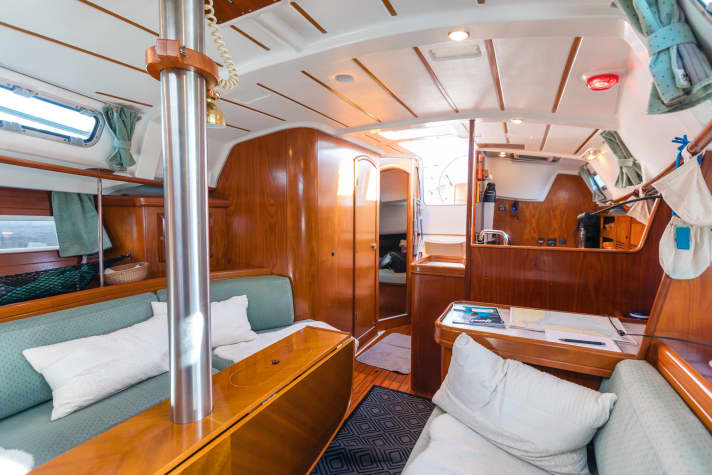
Plenty of space in the pantry and wet room
The starboard berth in the saloon, which can be extended using a cushion, measures 2.20 by 1.05 metres. As the saloon table provides solid protection against falling out, this is the ideal sea berth. On the port side, the length of the bench shrinks to 1.80 metres due to the navigation table. If you sleep comfortably here, you won't mind the standing height of 1.90 metres throughout. This is also tight from today's perspective. However, the exterior lines are still pleasing.
The galley and wet room are not in short supply. The former, at least in the two-cabin version, is downright huge. Two fridges, a gigantic storage compartment for provisions, cupboards and plenty of work space turn the U-shaped galley into a real workplace at sea. This also applies to the navigation system, which is located in front of the galley. Here, too, there is plenty of space for working and installing all kinds of appliances. Pleasing in the wet room: the separate, actually usable shower, which also serves as an oil locker. That fits.
You should pay attention to these points when buying a used Oceanis 361
The hull is made of solid laminate, which will cause few problems. The deck is more critical: The balsa core can rot away if it gets damp, for example at the fittings, especially if these have been fitted subsequently and not professionally. If the carrier material is damaged, the deck will become soft.
A teak deck can also become an expensive problem when it ages. If you want to be carefree when travelling in the long term, you need to look for one without a wooden deck. When buying, you should also check the play of the shaft in the stern tube bearing; more than one millimetre requires replacement. Equally important: the alignment of the motor to the shaft. The internal shaft seal needs to be replaced every seven years. However, it only costs around 100 euros. Otherwise, the usual points for a used boat should be considered first and foremost: Condition of sails, sprayhood, cake stand and lazy bag as well as upholstery, black water system, electrics, diesel tank.
Replacing these things simply costs money. The rudder bearings also wear out, but replacing them is not too much of a challenge. In short, the Oceanis raises few questions, which is also due to its solid construction. The interior woodwork in particular is durable, with solid laminates and good veneer thicknesses. There is another thing that deserves attention during an inspection: the hull and deck are glued together around the transom under the thick rubber moulding. Especially in the Mediterranean, where boats are often moored astern, ramming with the bridge can cause leaks here. Therefore, check the area carefully for signs of collision damage.
Oceanis 361: solid cruising boat that needs little maintenance
If you are looking for a solid cruising boat that requires little maintenance, is well equipped and is likely to retain its value, you are sure to find one between 70,000 and 80,000 euros in Europe, depending on the equipment. Traditionally, Beneteau also sold a lot to the USA. A whole series of boats can therefore be found there. However, buyers still have to pay import sales tax in Europe in addition to the transport costs. Alternatives to the Oceanis are of course the boats in Bavaria's Cruiser series, the Dufour boats such as the 365, or the Catalina 36 Mk II.
What they all have in common is their robust construction, unambitious sailing characteristics and plenty of space below deck. Only the Oceanis offers that certain French verve, the clever details such as the sliding passageway to the bathing platform, the pleasing lines or the very cosy layout below deck.
Measured values of the Oceanis 361
Sailing performance (without drift/current)
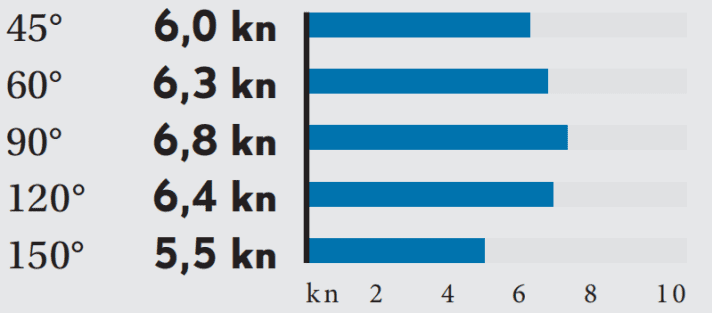
Wind speed: 12-16 kn (4-5 Bft), wave height: approx. 0.5 m
Potential STZ* = 4.5

Very cruising-orientated with top rig without trim. High sail carrying capacity from today's perspective
* Dimensionless number. Calculation: 2√S/3√V. The higher the value, the more sail area (S) the ship has in relation to the displacement (V)
Model history and design
The biggest difference in the various models is the number of cabins. The galley wins in the two-cabin version. The hull was built from solid laminate, the deck is a balsa sandwich. The joints were glued and screwed through the skirting board
Market situation
An Oceanis 361 costs between 65,000 and 80,000 euros, depending on its condition. It is traded less frequently in Europe than in the USA. Prices there are somewhat lower or exchange rate fluctuations can help. Factor in the import sales tax
Pay attention to this
Ensure that the deck is not soft, especially in the area of retrofitted fittings or teak decks. Check the alignment of the motor to the shaft and the condition of the motor bearings. Check the play of the shaft bearing and the rudder bearing. Osmosis is largely unknown, but possible. As boats imported from the USA are also in circulation, make sure you have conclusive proof of VAT!
Equipment and prices
- Base price 1999: 201,590 DM
- Used price: 65.000 - 80.000 €
Status 04/2024
Yacht evaluation of the Oceanis 361
The consistent cruising yacht is solidly built, easy to handle and cosy. A success all round!
Design and concept
- + Consistent cruiser
- + Clever use of space
- + Solid construction
Sailing performance and trim
- + Simple rig
- + Well controllable
Living and finishing quality
- + Very large pantry
- + Plenty of storage space
- - Berth aft not suitable for couples
Equipment and technology
- + Large water tank
- - Fittings rather small
Technical data Oceanis 361
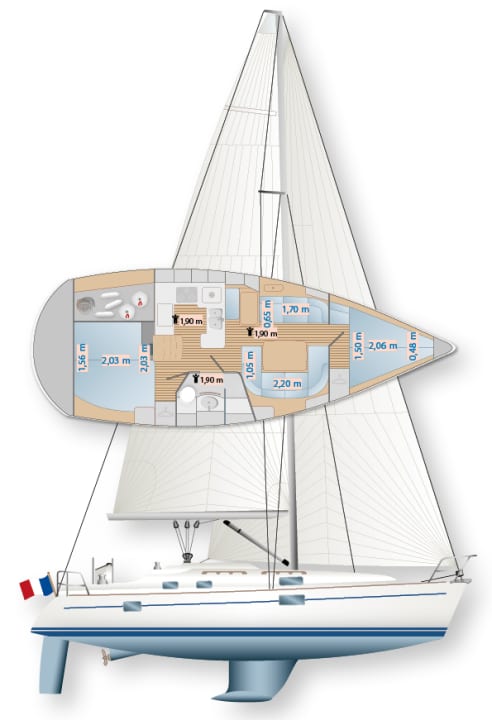
- Designer: Berret-Racoupeau
- CE design category: A
- Torso length: 10,80 m
- Total length: 11,10 m
- Waterline length: 9,48 m
- Width: 3,80 m
- Depth: 1,53 m
- Mast height above waterline: 15,10 m
- Theoretical torso speed: 7.48 kn
- Weight: 5,5 t
- Ballast/proportion: 1,85 t/34 %
- Mainsail: 28,6 m²
- Furling genoa (150 %): 35,9 m²
- machine (Volvo Penta): 21 kW/29 hp
- Fuel tank: 75 l
- Fresh water tanks (2): 380 l
- Holding tank: 50 l
Shipyard
Beneteau, France, www.beneteau.com
The article first appeared in YACHT 21/2023 and has been updated for the online version.

